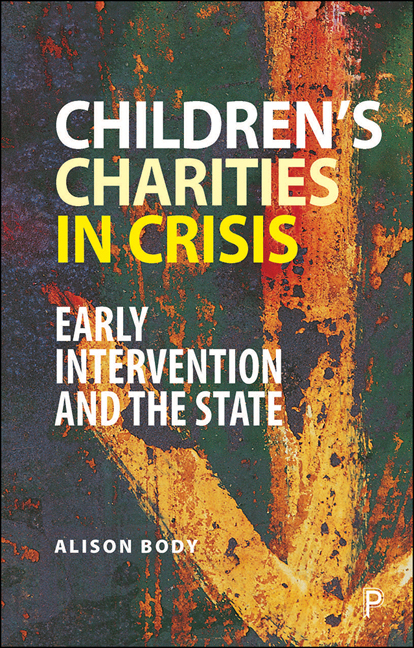Book contents
- Frontmatter
- Dedication
- Epigraph
- Contents
- List of Figures and Tables
- About the Author
- Acknowledgements
- Introduction
- Part I Preventative Services and Children’s Charities: Policy and Paradigm Shifts
- Part II On the Frontline of Early Intervention
- Part III The Lived Realities of Commissioning Children’s Early Intervention Services
- Part IV Concluding Thoughts
- Appendix: Data and Methods: Voices from the Frontline
- References
- Index
4 - State Education: the Relationships Between Schools and Charity?
Published online by Cambridge University Press: 04 March 2021
- Frontmatter
- Dedication
- Epigraph
- Contents
- List of Figures and Tables
- About the Author
- Acknowledgements
- Introduction
- Part I Preventative Services and Children’s Charities: Policy and Paradigm Shifts
- Part II On the Frontline of Early Intervention
- Part III The Lived Realities of Commissioning Children’s Early Intervention Services
- Part IV Concluding Thoughts
- Appendix: Data and Methods: Voices from the Frontline
- References
- Index
Summary
Schools are increasingly having to behave and think like charities. The funding simply isn't there to support our most vulnerable children, and the support services around us have been demolished – we now act as a charity to protect our children. (Headteacher)
Introduction
Education is a core service which provides the grounding, qualification and socialisation for children and young people, which is likely to have an impact on them for the rest of their lives (Biesta, 2013). As a primary tool for increasing social equality, achieving aspirations and supporting children and young people to become active, pro-social citizens, it is unsurprising that this is an area of interest for many philanthropists, charities and voluntary sector organisations. Similarly, as schools face increasing fiscal, performance, recruitment and retention pressures, we see them increasingly turning to voluntary action – that is fundraising and volunteers – to counter resource pressures.
This chapter explores this core concept, the relationship between education and charity. Focusing particularly on primary education which concentrates on 4–11 year-olds, we investigate how charities shape and support education, and indeed how schools engage in voluntary action to support their day to day delivery. We consider the implications of this work and what this means for the charitable sector and early intervention. In this chapter we deliberately avoid the topic of independent schools and charitable status. This is not to suggest that this topic does not warrant research; it does in fact deserve significant attention from policymakers, practitioners and academics, but it simply is not the topic up for debate within this chapter.
We first explore the marketisation of education (that is the exposure of education to market forces) tracking the policy history and, most recently, funding reforms, which have meant that schools increasingly have to squeeze budgets and find new ways to increase their resources. We view what this voluntary action in primary education looks like through two lenses: first, how charity shapes education, and second, how schools are fundraising and encouraging volunteering in schools. We finally conclude with what this means for schools, and what is most important, what this means for the children they seek to serve.
- Type
- Chapter
- Information
- Children's Charities in CrisisEarly Intervention and the State, pp. 81 - 106Publisher: Bristol University PressPrint publication year: 2020



